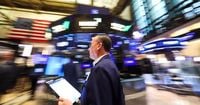U.S. stocks suffered steep losses on Monday, April 21, 2025, as President Donald Trump intensified his attacks on Federal Reserve Chair Jerome Powell, raising concerns about the independence of the central bank. All three major indexes tumbled more than 2%, with the tech-heavy Nasdaq Composite leading the decline, reflecting investor anxiety over the ongoing trade tensions and the economic outlook.
The Dow Jones Industrial Average fell 971.82 points, or 2.48%, closing at 38,170.41. The S&P 500 lost 124.50 points, or 2.36%, to finish at 5,158.20, while the Nasdaq Composite dropped 415.55 points, or 2.55%, ending at 15,870.90. The S&P 500 is now 16% below its record closing high from February 19, 2025, and if it closes 20% lower, it would officially enter a bear market.
In a post on his Truth Social account, Trump warned that the U.S. economy is headed for a slowdown “unless Mr. Too Late, a major loser, lowers interest rates NOW.” This statement has raised alarms among investors about potential political interference in monetary policy, which could undermine the Federal Reserve's autonomy. Jed Ellerbroek, a portfolio manager at Argent Capital Management, expressed concern, stating, “Countries that have an independent central bank grow faster, have lower inflation; they have better economic outcomes for their people. And politicians trying to influence the Fed is a really bad idea, and it’s very scary for the market.”
The backdrop to these market fluctuations is the escalating Sino-U.S. trade tensions, with China warning other nations against making agreements with the United States that could disadvantage Chinese interests. This warning has added fuel to the already strained tariff war between the two largest economies in the world. Ellerbroek noted that companies are uncertain about how to respond, awaiting clarity from the U.S. regarding tariff rates. He remarked, “What makes it dispiriting, I think, is the fact that this is like self-inflicted; we’re in this situation by choice, by this administration’s choice.”
As the market reacted to these developments, all 11 major sectors in the S&P 500 ended in negative territory. The technology and consumer discretionary sectors faced the largest percentage losses. Tesla shares dropped 5.8% after reports indicated a delay in the production launch of its stripped-down version of the Model Y. Nvidia also fell 4.5% following news that Huawei Technologies is set to begin mass shipments of an advanced AI chip to customers in China as early as next month.
Amid these stock market declines, gold prices surged to a record high, exceeding $3,400 a troy ounce, as investors sought safe-haven assets in light of the market volatility. The ICE U.S. dollar index, which measures the dollar against a basket of major currencies, fell more than 1%, reaching its lowest level in three years. Yields on longer-term Treasurys also rose, with the 10-year Treasury yield climbing to 4.39%.
In addition to the domestic market concerns, international trade data revealed a significant drop in exports from South Korea to the U.S. this month, signaling potential impacts from the ongoing trade disputes. The Nasdaq, which had already been under pressure, experienced a decline of around 2.5%, having been down as much as 3% earlier in the day.
As the first-quarter earnings season heats up, investors are watching closely. Analysts expect a year-on-year earnings growth of 8.1% for the S&P 500, down from an earlier projection of 12.2% at the beginning of the quarter. Out of the 59 companies that have reported their earnings so far, 68% have surpassed Wall Street expectations, providing a glimmer of hope amidst the broader market turmoil.
Market analysts are keeping a close eye on the upcoming earnings reports from major firms, hoping that strong performances could help stabilize the market. However, the uncertainty surrounding Trump's trade policies and his administration's stance on the Federal Reserve continues to weigh heavily on investor sentiment.
In the broader context of global markets, Japan's Nikkei index fell 1.3%, while China's CSI 300 managed a slight increase of 0.3%. Markets in Hong Kong and Europe were closed for the Easter holiday, limiting international trading activity.
The financial landscape remains precarious as investors navigate the dual challenges of political tensions and economic uncertainty. With the Fed's independence and the ongoing trade war at the forefront of concerns, the coming days will be critical in determining the direction of U.S. markets.





